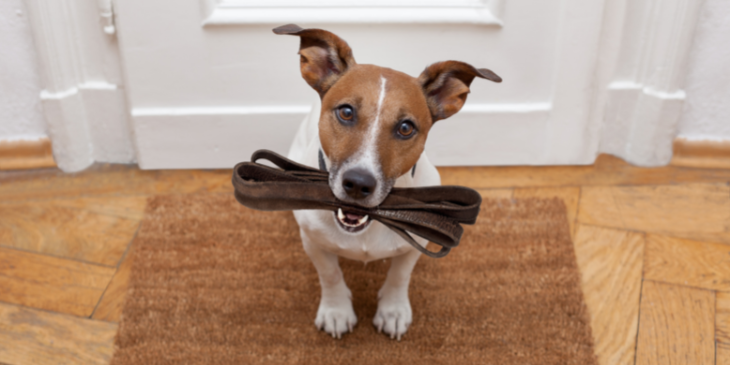Collar vs Harness for Puppy: How to Choose

Contents
Does it matter if you choose a collar vs a harness for your puppy? Why are there so many different types, and what are they for? Is a harness safer or more comfortable for your puppy than a collar?
Every new pet parent wants the best for their puppy, but with so many options, it’s easy to get overwhelmed. After all, choosing the right equipment can have a major impact on your puppy’s health and safety, as well as on the success of your training efforts!
When it comes to choosing between a collar vs harness for puppy, understanding the pros and cons of each type of equipment is essential for making an informed decision. The best choice for your puppy can vary based on breed, personality type, or even the situation. There’s a lot to consider, so let’s dive in!
Pros and Cons of Choosing a Collar for Your Puppy

A collar is ideal for securing ID tags and your puppy’s GPS tracker, but it’s not the best choice for training your puppy to walk on a leash.
We’re all pretty familiar with the basic function and purpose of a dog collar. They’re simply designed to go around your dog’s neck to provide a convenient place to attach a leash and identification tags. They come in a variety of styles with endless color options and adornments.
So, let’s consider the pros and cons of choosing a collar for your puppy.
Pros
- Collars tend to be more comfortable for dogs and puppies than harnesses because they’re lightweight and less restrictive. Most puppies get used to them quickly and don’t mind wearing them consistently on a daily basis.
- The collar is a great place to attach your puppy’s ID tag, proof of vaccinations, and GPS pet tracker for daily wear. If your puppy ever escapes the backyard or runs out the door, a collar and ID tag could help him find his way home quickly and safely. Anytime your puppy isn’t in his crate, he should be wearing his collar and ID tags.
- Collars are easier to put on and take off than a harness, which can be a huge benefit when you’re potty training or dealing with a rambunctious puppy. If you’re just stepping out for a quick potty break in the yard, collars are super convenient.
Cons
- Collars put pressure on the dog’s trachea and can lead to trachea damage if the dog pulls excessively. Over time, this could cause the tracheal rings to weaken, which can lead to a collapsed trachea. Collars aren’t a good option for leash training your puppy or for walking any dog who has breathing issues or a strong tendency to pull.
- Collars can increase pressure in the eyes because of the force generated when the dog pulls. They’re not recommended for dogs who have eye conditions like glaucoma, protruding eyes, or weak corneas, especially if the dog is likely to pull excessively on its leash.
- Research is still ongoing, but some experts believe that collars can damage a dog’s thyroid gland. It may be possible that the trauma created by excessive and repeated pulling, especially in large dogs, can inflame the thyroid and lead to an auto-immune response.
- Collars can slip over the head easily, especially for breeds whose neck is nearly as big as their head, like Whippets and Bulldogs. They’re not a good option for dogs who are likely to pull or back out of their collar and run away or wind up in a dangerous situation.
Collar Types and What They’re For
Now that you’re familiar with the pros and cons of using a collar for your puppy, let’s take a look at the different types of collars available and what they’re for.
Flat and Rolled Collars
Flat and rolled collars are the most common and affordable type of dog collar. They’re available in a wide range of materials and colors and can easily be dressed up with bandanas, bows, or bling to show off your puppy’s personality. They’re a great option for attaching tags and for dogs who walk nicely on a leash.
Safety Collars
Safety collars are flat collars that have a special fastener that’s designed to release when the puppy pulls hard. The breakaway design is a fantastic choice for everyday wear.
They’re also a great option for times when you want your pup to wear an ID tag, but you’re concerned about choking, such as at the dog park or on rambunctious play dates. However, safety collars are not a good option for leash walking.
Choke Collars and Prong Collars
Prong and choke collars are typically used for training. They are designed to slip over the dog’s head and put pressure on the neck when the dog pulls on its leash.
When used correctly, some trainers find that they’re a useful tool for getting the dog’s attention, but they should never be used as a form of punishment. These collars are not intended for everyday use and should only be used under the advice and supervision of a professional trainer.
Martingale Collars
Martingale collars are a hybrid between a flat or round collar and a choke collar. They’re designed to be less restrictive because they have stops that prevent them from squeezing the dog’s neck when it pulls. They sit higher on the dog’s neck, so they avoid the trachea while still offering more control and increasing the dog’s responsiveness.
They can be useful for training, but finding the right fit is essential. A poorly fitted martingale could slip down the neck and put pressure on the trachea, or it could slip over the head altogether, allowing your puppy to run away.
Martingales should only be used for training and never left on a dog unsupervised. Be sure to consult with a professional trainer to ensure that you’re using the collar properly for your puppy’s safety.
Pros and Cons of Choosing a Harness for Your Puppy

A harness is safer for your puppy when he’s walking on a leash, but it’s not the best choice for comfortable everyday wear.
Although they perform similar functions, there are some pretty significant differences between a harness and a collar. This type of wearable equipment is also used to attach a leash to your dog, but it’s not the best place to secure an ID tag or proof of vaccinations because it’s not ideal for all-day wear.
Rather than simply going around the dog’s neck, a harness fits around the torso, behind the front legs, and distributes tension across the chest and shoulders, which is best for leash walking. Let’s explore the pros and cons of using a harness on your puppy.
Pros
- Harnesses reduce tension on the neck and trachea by dispersing the pressure over a larger surface area. This makes them ideal for dogs and puppies who tend to pull excessively, have neck, eye, or breathing problems, or are more prone to trachea issues.
- Harnesses fasten securely around the dog’s body, which makes them more difficult to slip when fitted properly. This is important for puppies and adult dogs who try to back out of their collar and could end up lost or in an unsafe situation.
Cons
- Some harnesses can encourage pulling, especially in working breeds that were bred to retrieve or pull heavy objects.
- Harnesses can be difficult to put on since they have to go around the neck and the front legs. This can be an issue if you’re dealing with a squirming puppy.
- Harnesses can be uncomfortable because they’re bulkier and heavier on the dog. Some dogs may not like wearing a harness because it restricts their movement or feels too tight. Others may not like putting their head or legs through the harness.
- Harnesses are easier for your puppy to reach, which means he’s more likely to chew on his harness. They can also become entangled more easily in things like crates, fences, bushes, or even playmates. Removing the harness when it’s not in use is crucial for your puppy’s safety.
- Harnesses can become entangled in your puppy’s coat, especially if he has very long fur. This can lead to mats and tangles that are very difficult to brush out, so removing the harness when it’s not in use is essential.
Harness Types and What They’re For
Now that we’ve covered the pros and cons of using a harness on your puppy, let’s take a look at the different harness types and what they’re for.
Back-Clip Harnesses
Back-clip harnesses are designed with a D-ring between the shoulder blades for attaching the leash. They’re the most affordable and common type of dog harness and come in a wide range of materials and colors, including chew-proof options for destructive dogs and puppies.
Back-clip harnesses are a good option for puppies who are still learning how to walk on a leash because they put pressure on the chest and underarms, rather than the neck. However, they can encourage pulling, so they’re not a great choice for dogs who are heavy pullers.
Front-Clip Harness
Front-clip harnesses are designed with a D-ring on the front of the chest, which is meant to discourage pulling. They can be a good choice for breeds who are heavy pullers, but finding the proper design is key. Look for a front-clip harness that’s y-shaped across the chest to avoid shortening your puppy’s stride and affecting its posture.
Dual Clip Harness
Dual clip harnesses come with a D-ring in the front and on the back between the shoulder blades. They are designed to be used with a special leash that has two clips, providing greater control for leash walking and training.
Typically the back clip provides a strong connection with the pup, while the front clips can help you redirect your puppy if he pulls or lunges. This type of harness can be a great choice for leash training, provided you take the time to learn how to use it correctly.
Tightening Harness
Some trainers recommend a tightening harness for dogs who tend to pull excessively. This type of harness is designed to fit comfortably and constrict if the dog begins to pull. For some dogs, the constricting harness discourages pulling, making it a useful tool for leash training.
This type of harness should be used under the direction and supervision of a professional trainer. Be sure to choose one that doesn’t tighten too much, potentially causing pain or injury to your puppy.
No-Pull Harness
The no-pull harness, sometimes called a head halter harness, is designed to go around the dog’s head rather than the chest. It has a strap that goes around the neck, in addition to a loop that goes around the snout. The leash is attached to a D-ring under the chin.
This type of harness is useful for keeping your dog’s attention and walks and for discouraging pulling. When the dog pulls or lunges, it tightens around the snout gently and pulls the dog’s head down and toward you, giving you greater control.
The no-pull harness does not cause pain, and it doesn’t hold the mouth closed like a muzzle. However, finding the proper fit is essential and some dogs may strongly resist having a contraption placed over their face. Keep in mind that head halters won’t work for dogs who have a flatter snout.
No pull harnesses should never be yanked, used with force, or used with a retractable leash to avoid potential pain and injury to your dog.
When to Use a Collar for Your Puppy
No matter which type of collar you choose, finding the proper fit is crucial. A collar that’s too tight will be uncomfortable, while one that’s too loose can easily get entangled in fences and other objects, or even stuck in your dog’s mouth.
It’s also important to remember that collars should always be removed when your pup is in the crate for safety reasons. Here’s when to use a collar for your puppy:
- For Identification and Tracking Purposes: Every dog or puppy should wear a collar with identification tags and a GPS tracker whenever they’re not in a crate. Even if your dog has a microchip (and he definitely should), an ID tag makes it easier for a neighbor or anyone else who finds your dog to reach you immediately.
- For Quick Potty Breaks: Using a collar for quick potty breaks is fine, as long as your puppy isn’t prone to pull too hard on his leash or slip the collar off over his head.
- Your Puppy Has Mastered the Art of Walking on a Leash: If your puppy walks on a leash without pulling, it’s fine to use a collar, as long as he doesn’t have a health condition that makes it dangerous to do so.
- Under the Supervision of a Professional Trainer: Professional trainers sometimes find that the right type of collar can offer more control over a rambunctious puppy and help to keep its attention. If your trainer recommends it and provides instructions for safe use, it’s ok to use a collar for training, as long as your vet also gives the green light.
When to Use a Harness for Your Puppy
No matter which type of harness you choose, ensure that it’s properly fitted for your dog’s safety. Harnesses are not meant to be left on your pup, and should only be worn for walking on a leash. Here’s when to use a harness for your puppy:
- For Leash Walking and Leash Training: It’s best to use a harness for leash walking, especially if your puppy is still learning and is likely to pull or slip out of his collar. In general, harnesses are also the safest option for training your puppy to walk on a leash.
- Your Puppy is Prone to Tracheal Collapse: A tracheal collapse is a medical condition where the trachea closes in on itself and makes it difficult for the dog to breathe. Small dogs, especially toy and miniature breeds, are more prone to trachea collapse because they are more fragile.
- Your Puppy is Prone to Neck or Spinal Issues: Long-bodied breeds, like basset hounds and dachshunds, are more prone to neck and spinal issues, including slipped discs, pinched nerves, and intervertebral disk disease (IVDD).
- Your Puppy is a Brachycephalic Breed: Brachycephalic breeds have flatter noses and larger, bulging eyes, making them more prone to respiratory and eye issues. Bulldogs, Shitzus, Pugs, and Boxers are good examples.
Collar vs Harness for Puppy: Which One is Better?
Collars and harnesses each have their own advantages, and most puppies should have both. A collar is better for daily wear and identification, while a harness is best for training and walking on a leash.
However, no collar or harness is a substitute for proper leash training. If you want your puppy to be as safe as possible when walking on a leash, you must put in the time and effort required to teach him. But being informed about the pros and cons of various equipment will help you keep your puppy safer while he’s learning the ropes and beyond.
